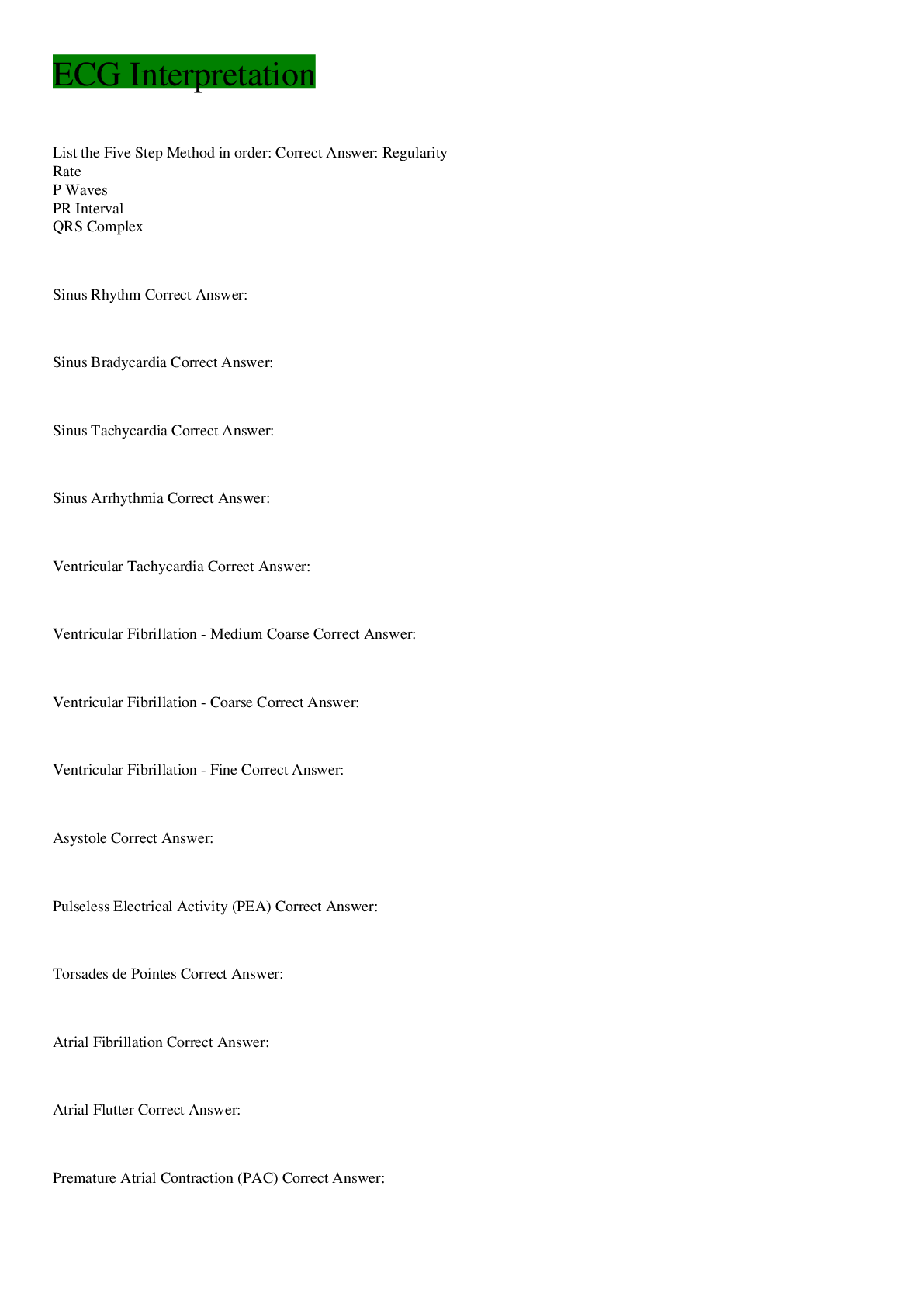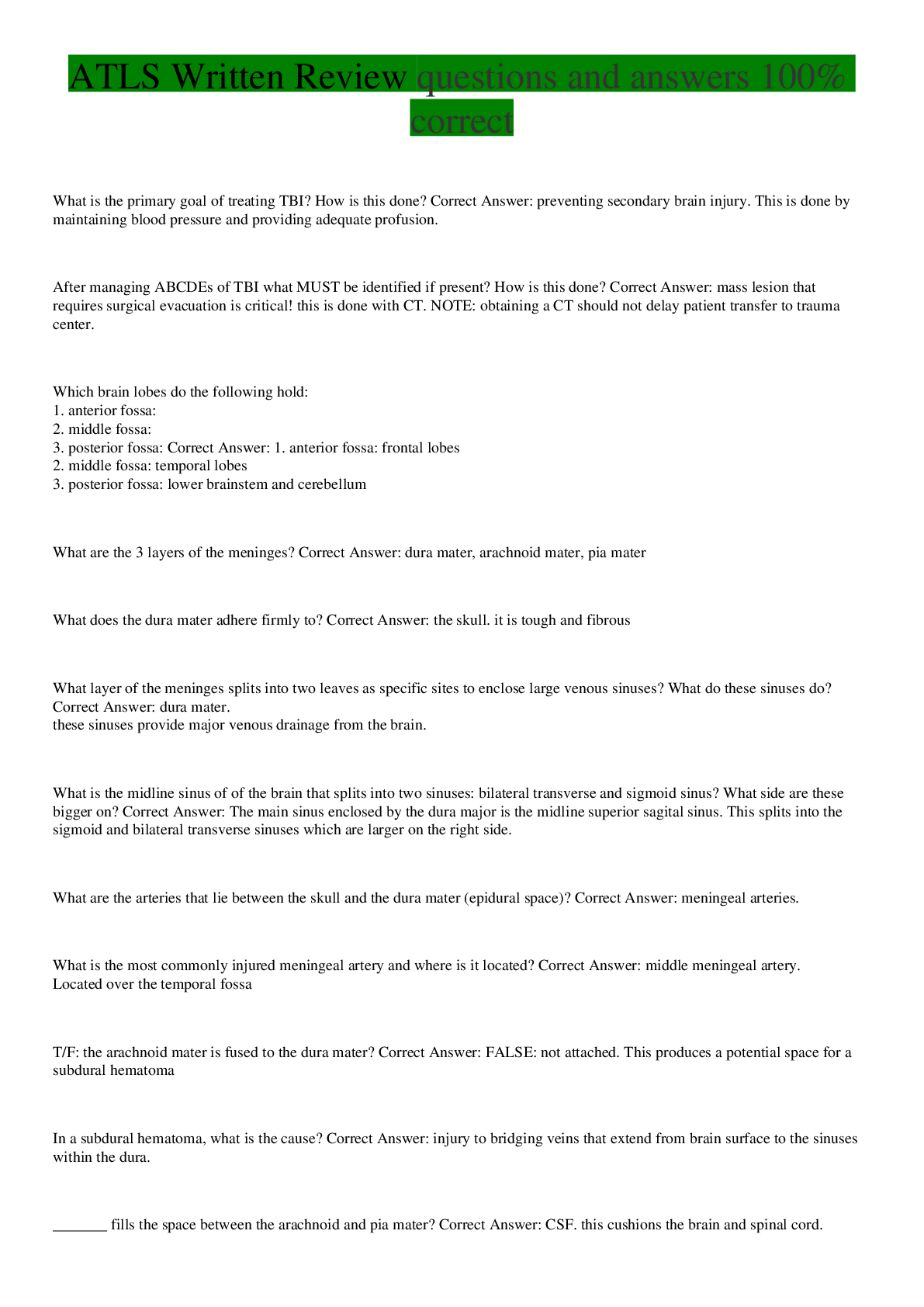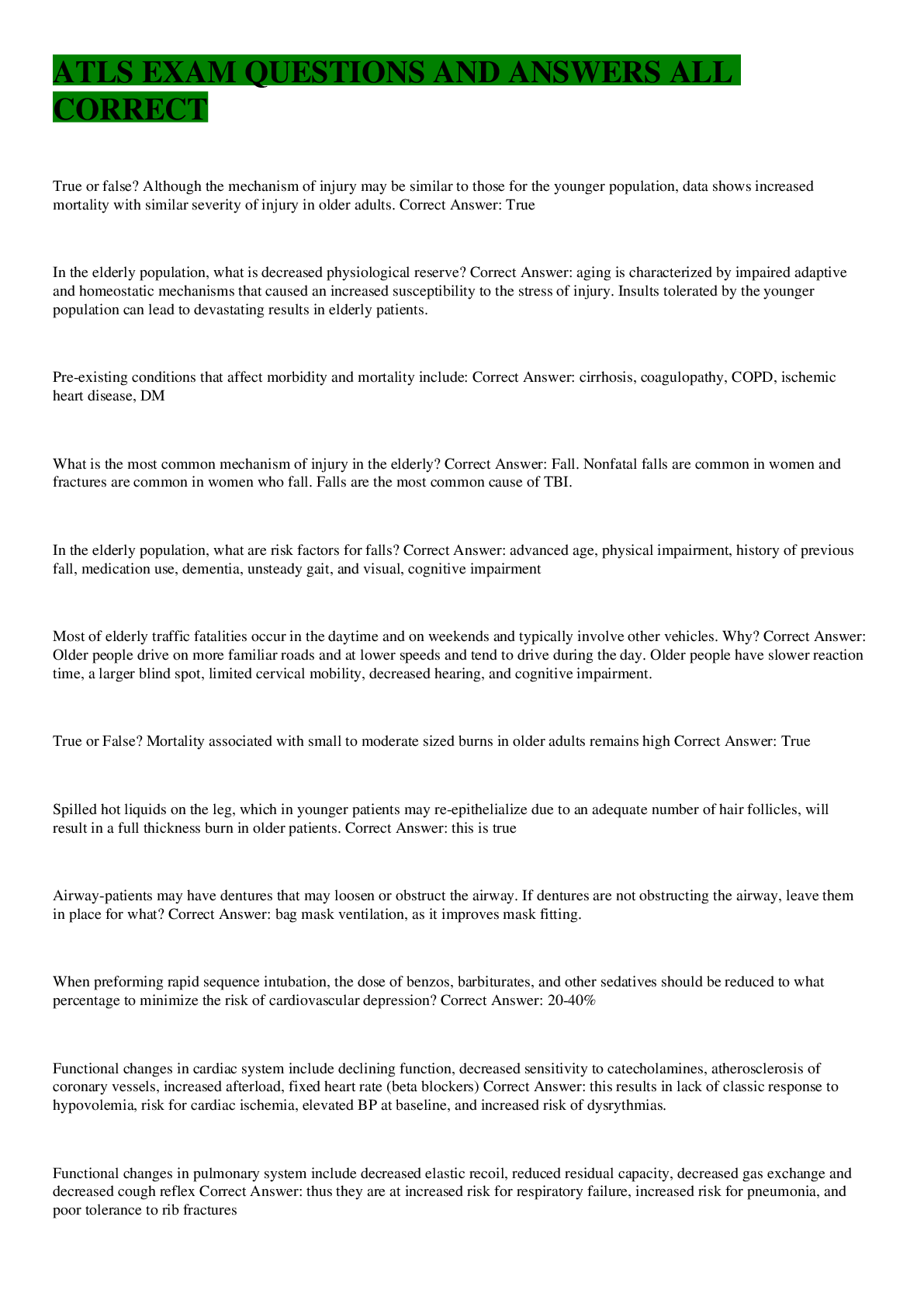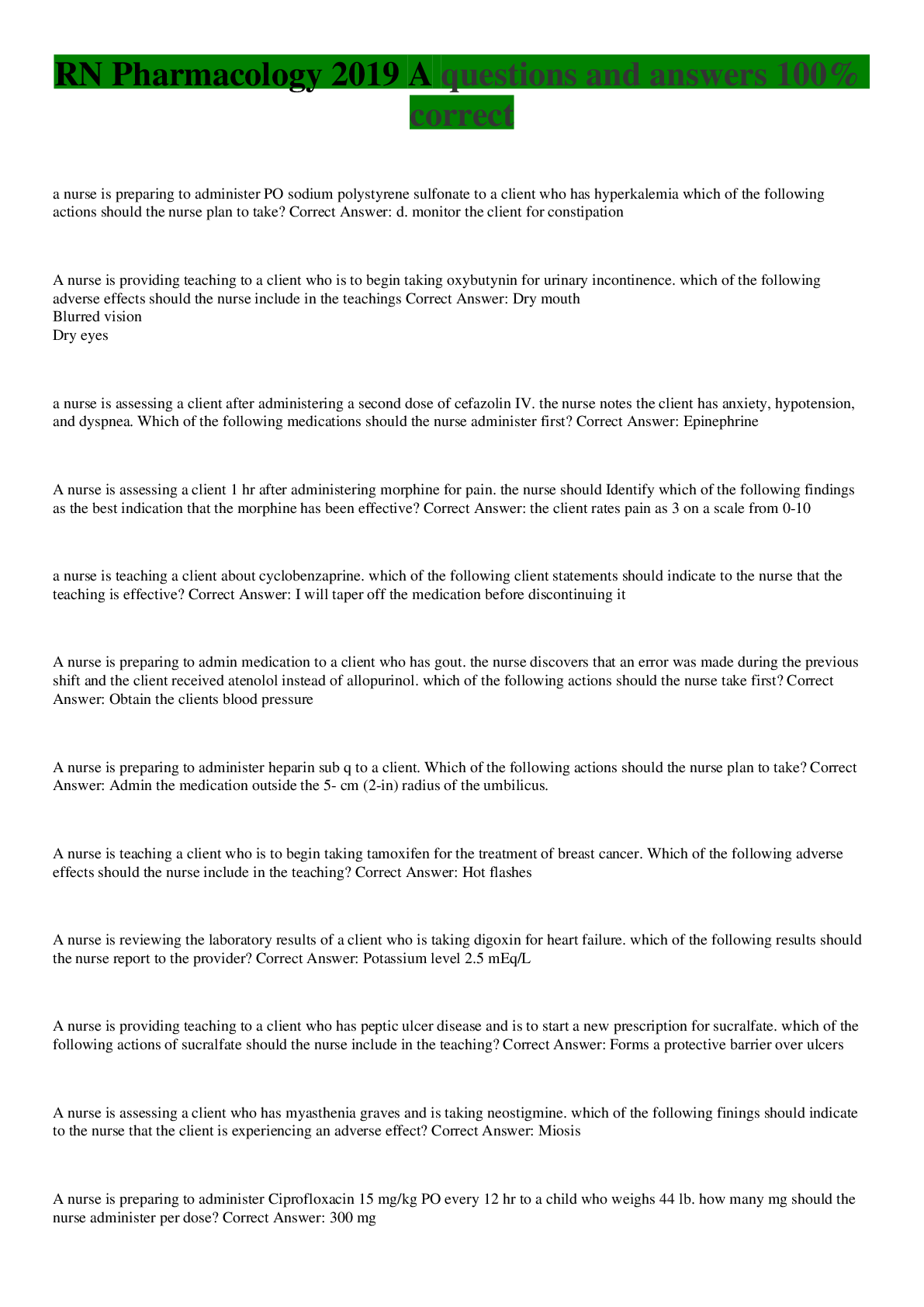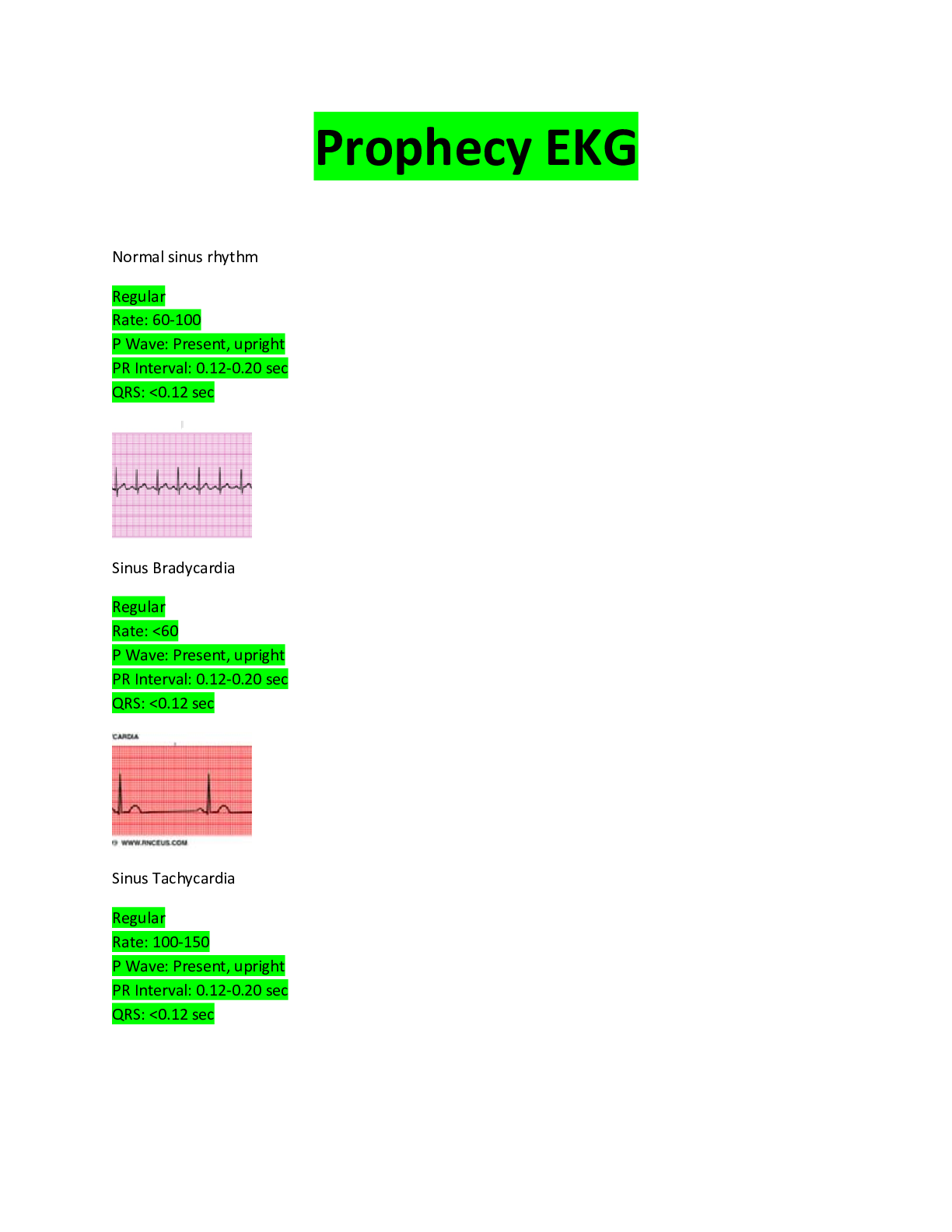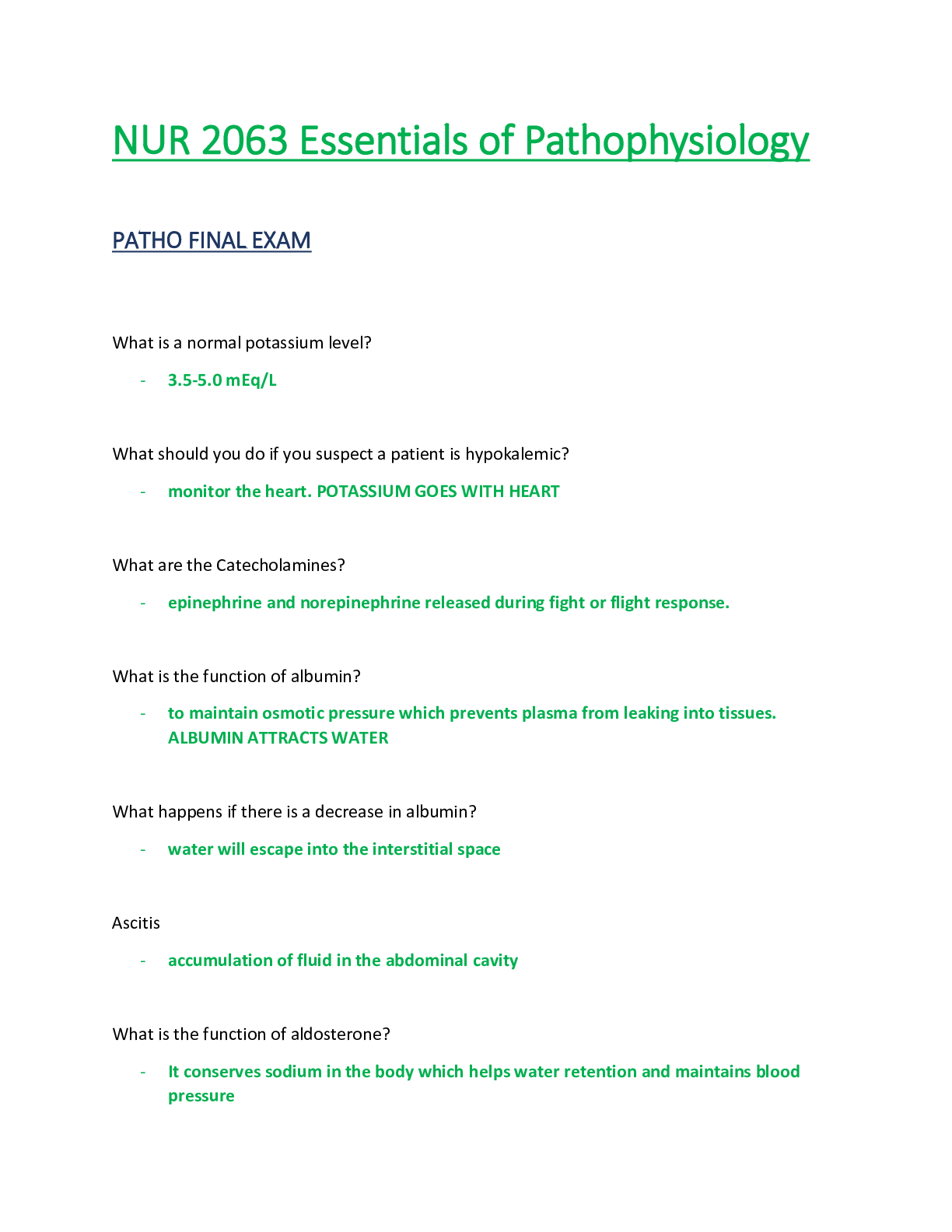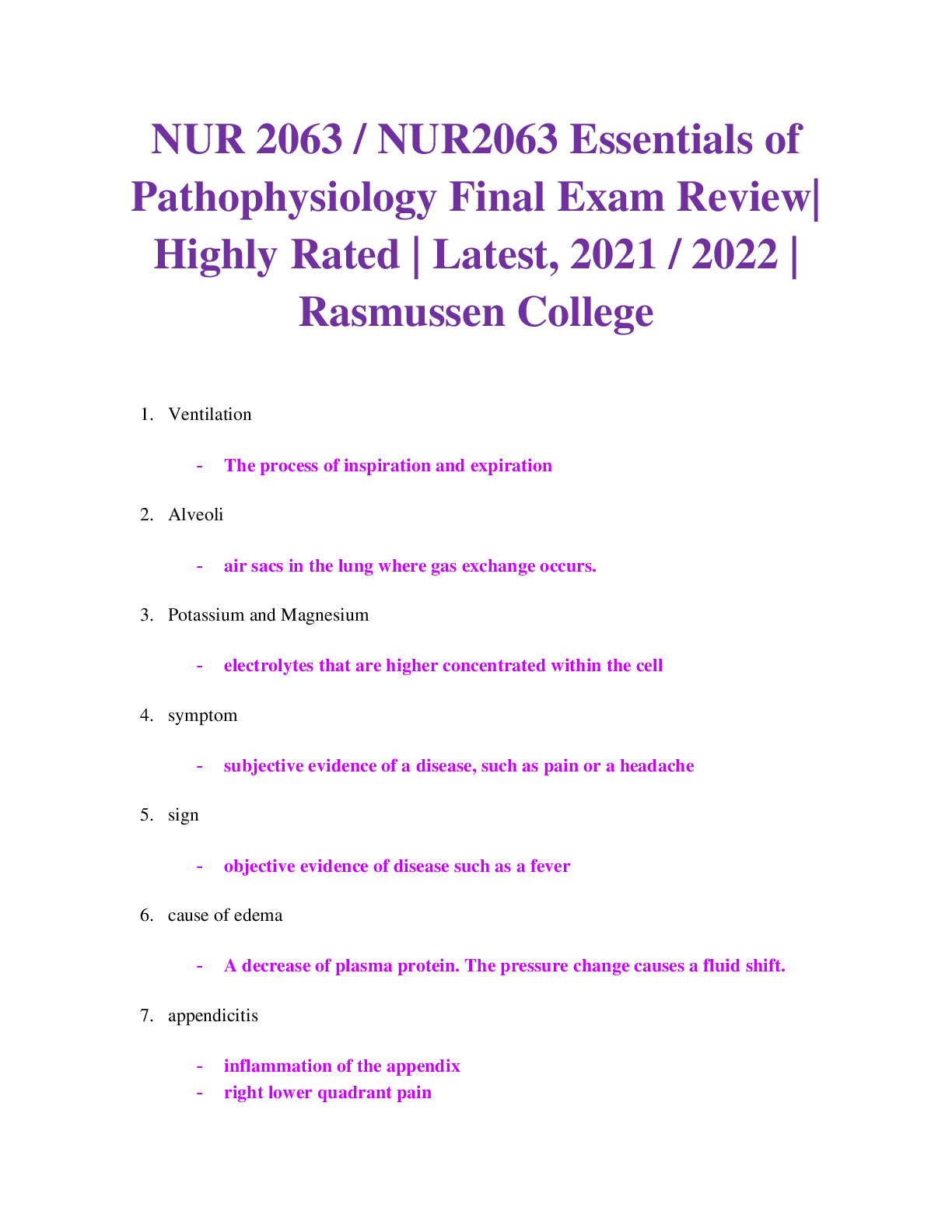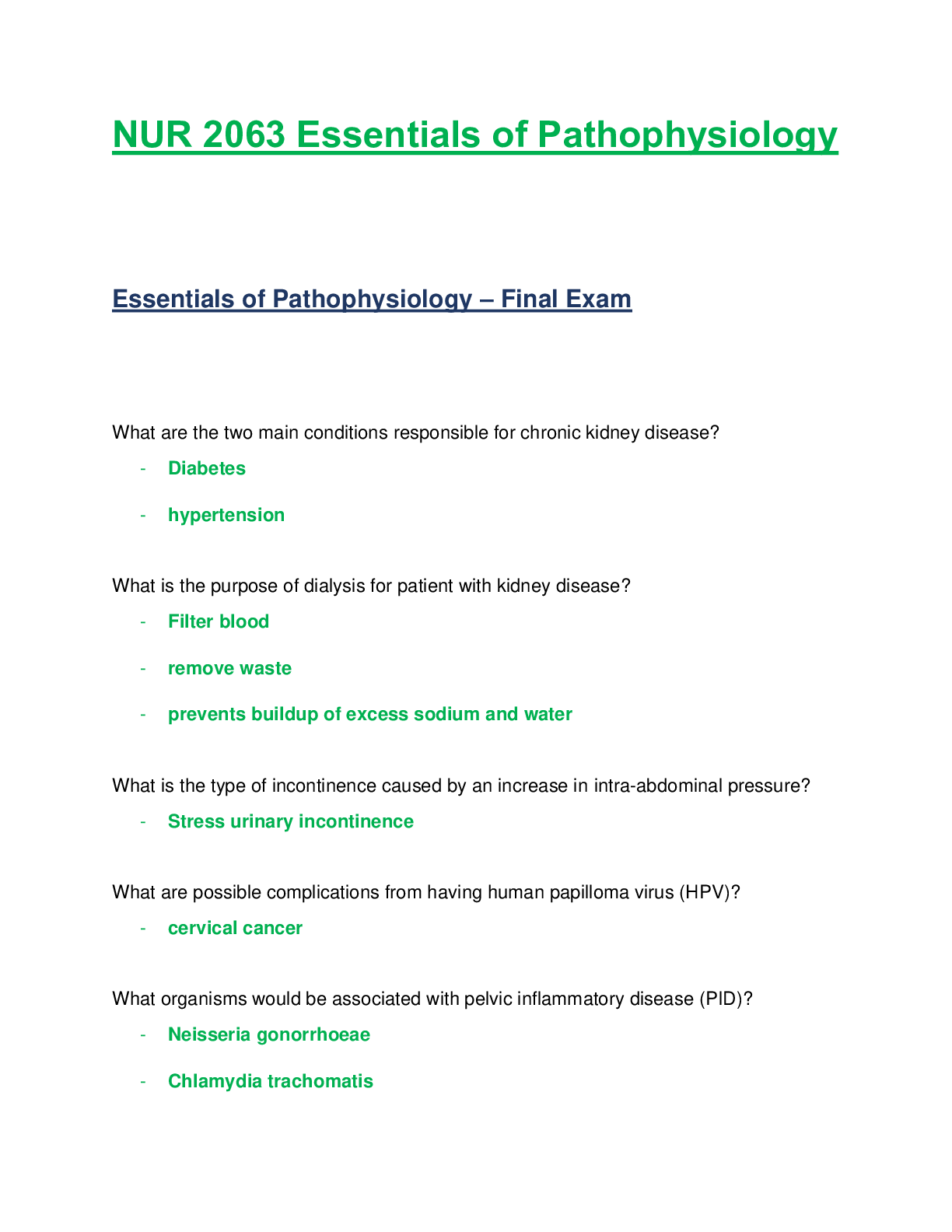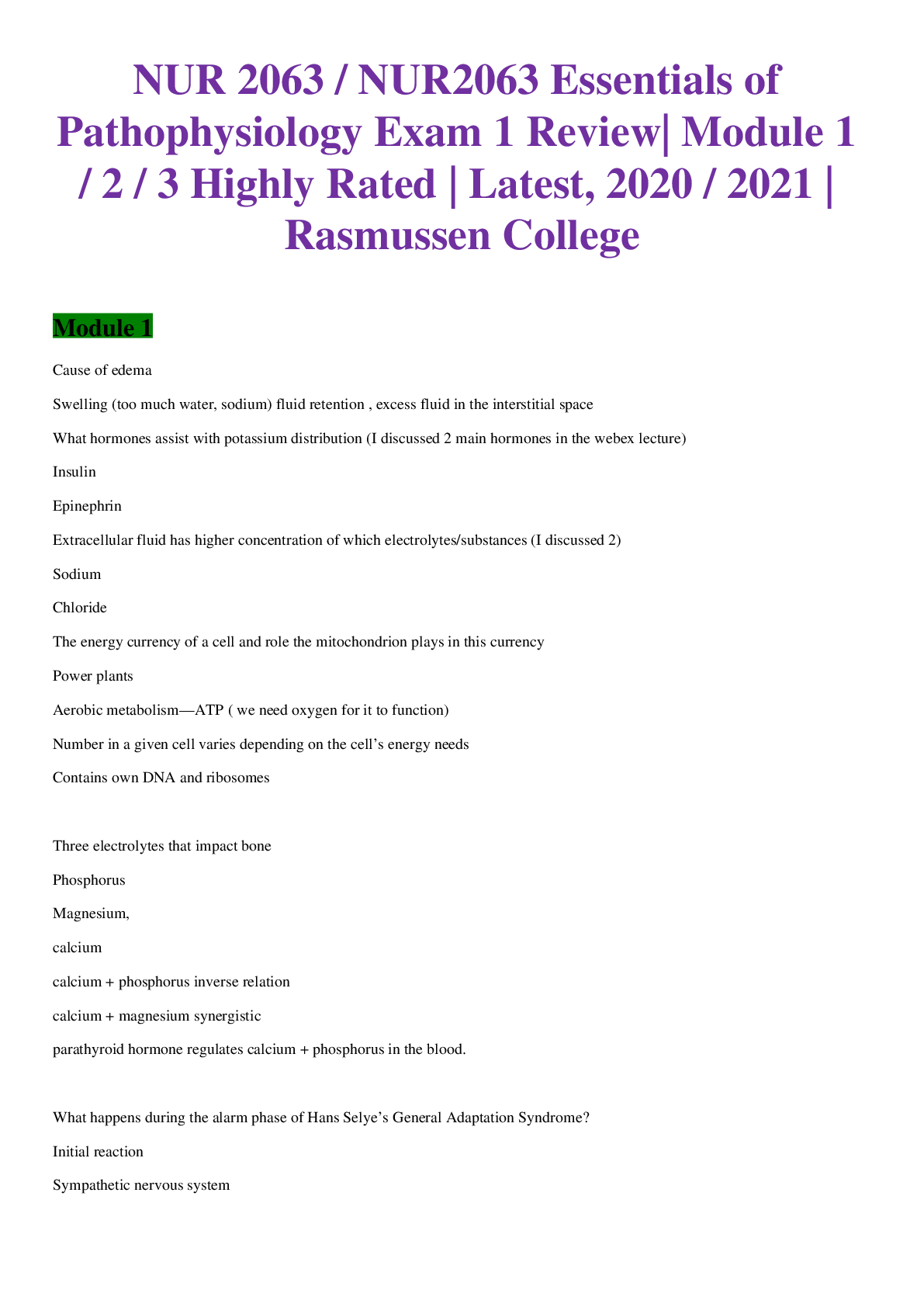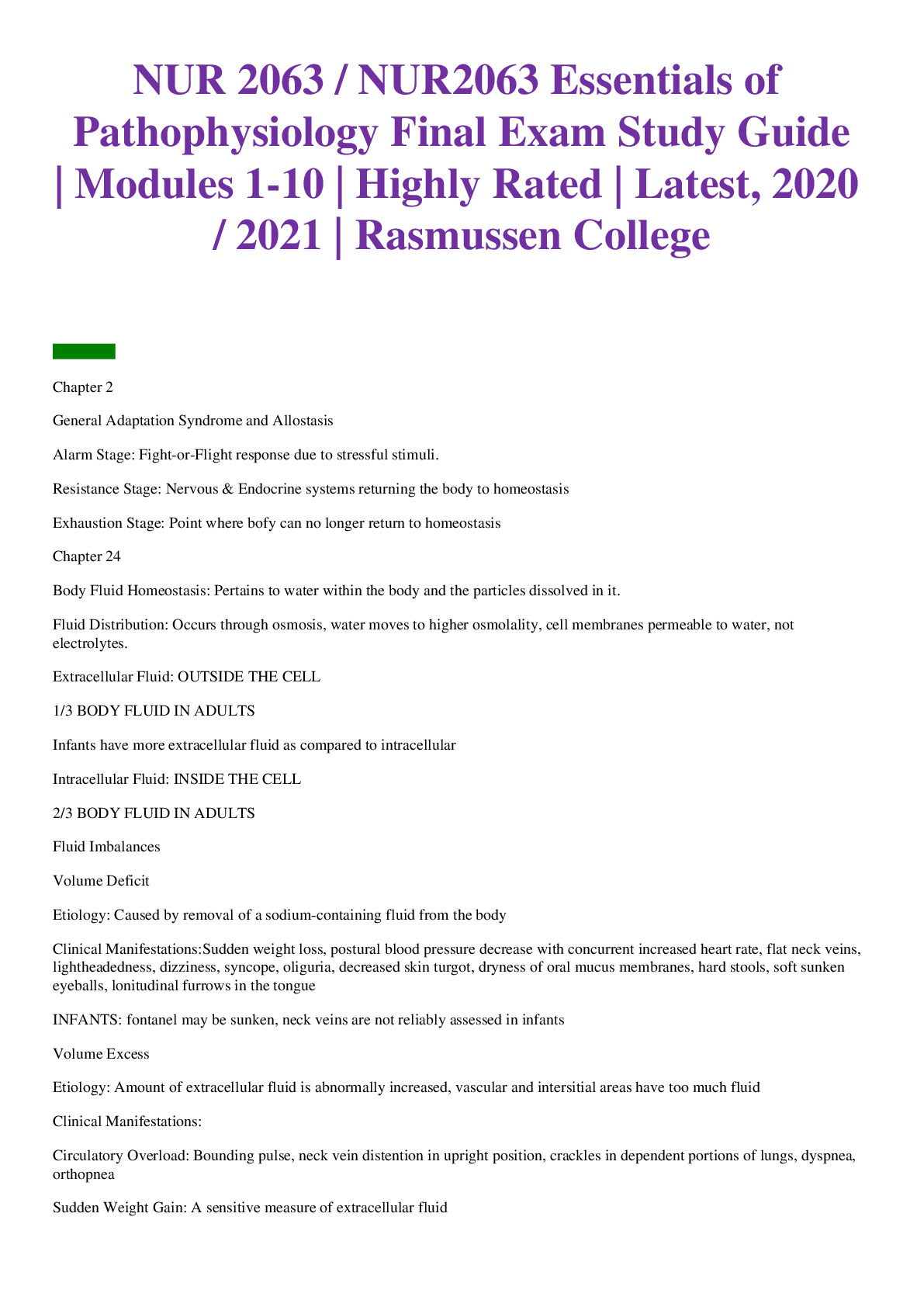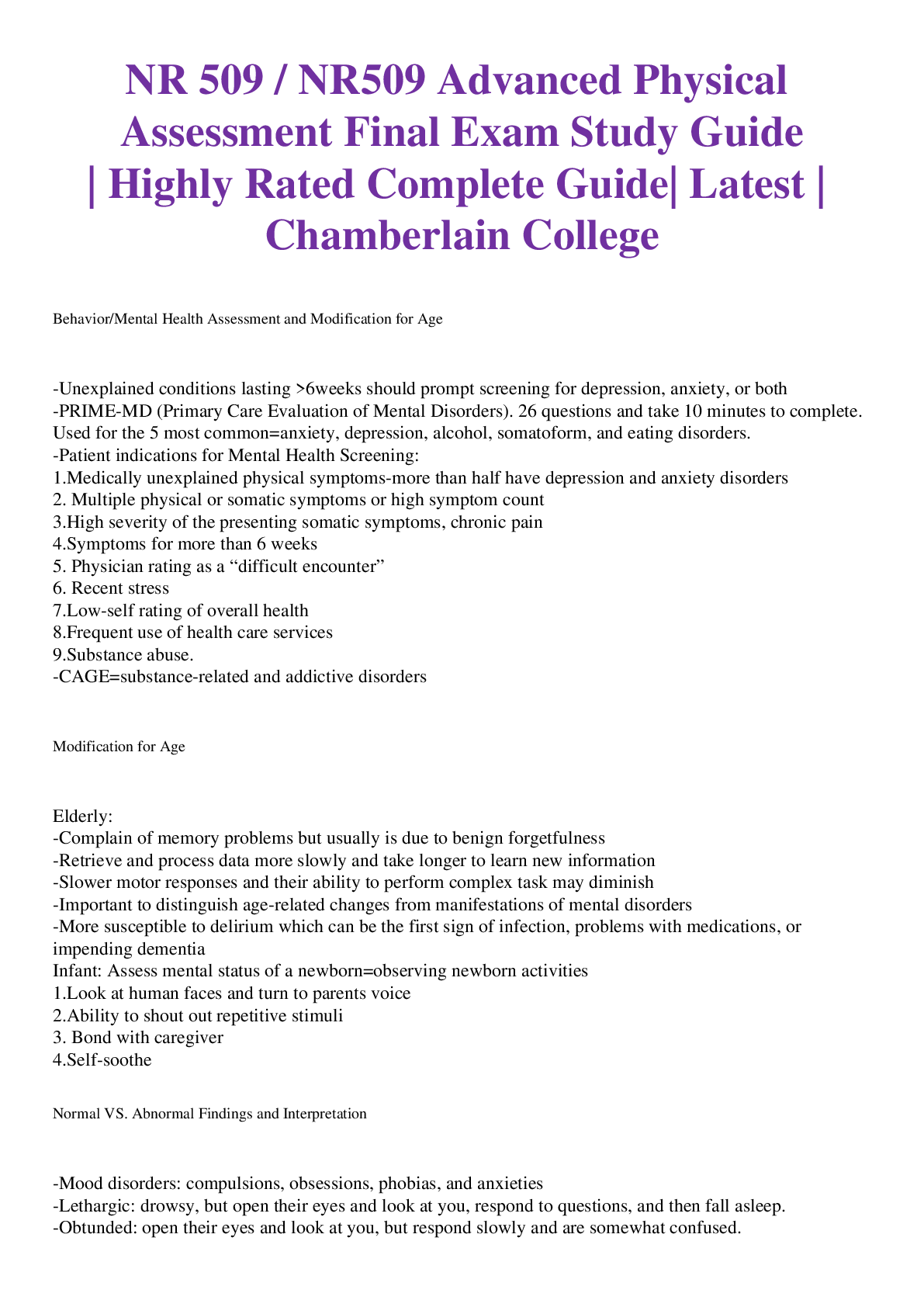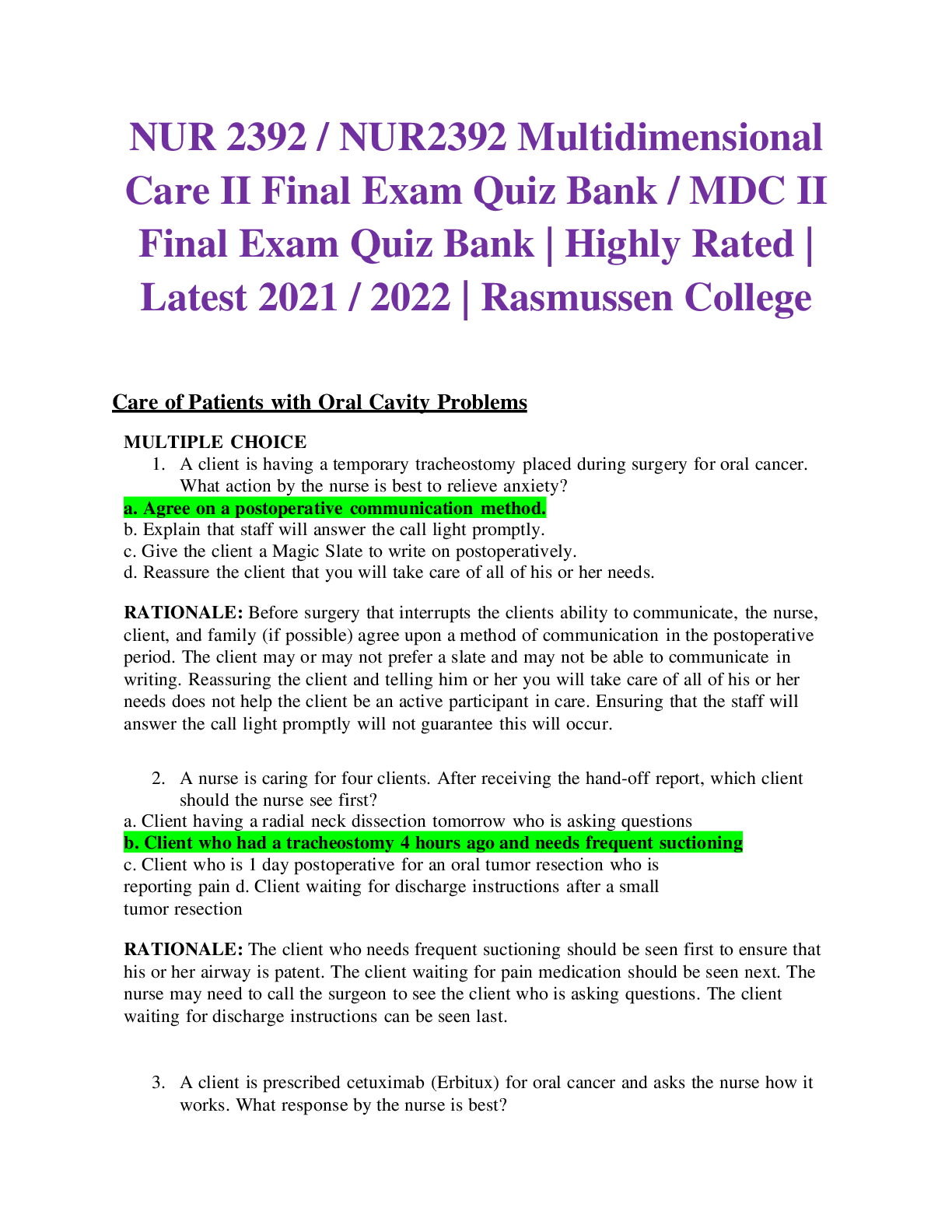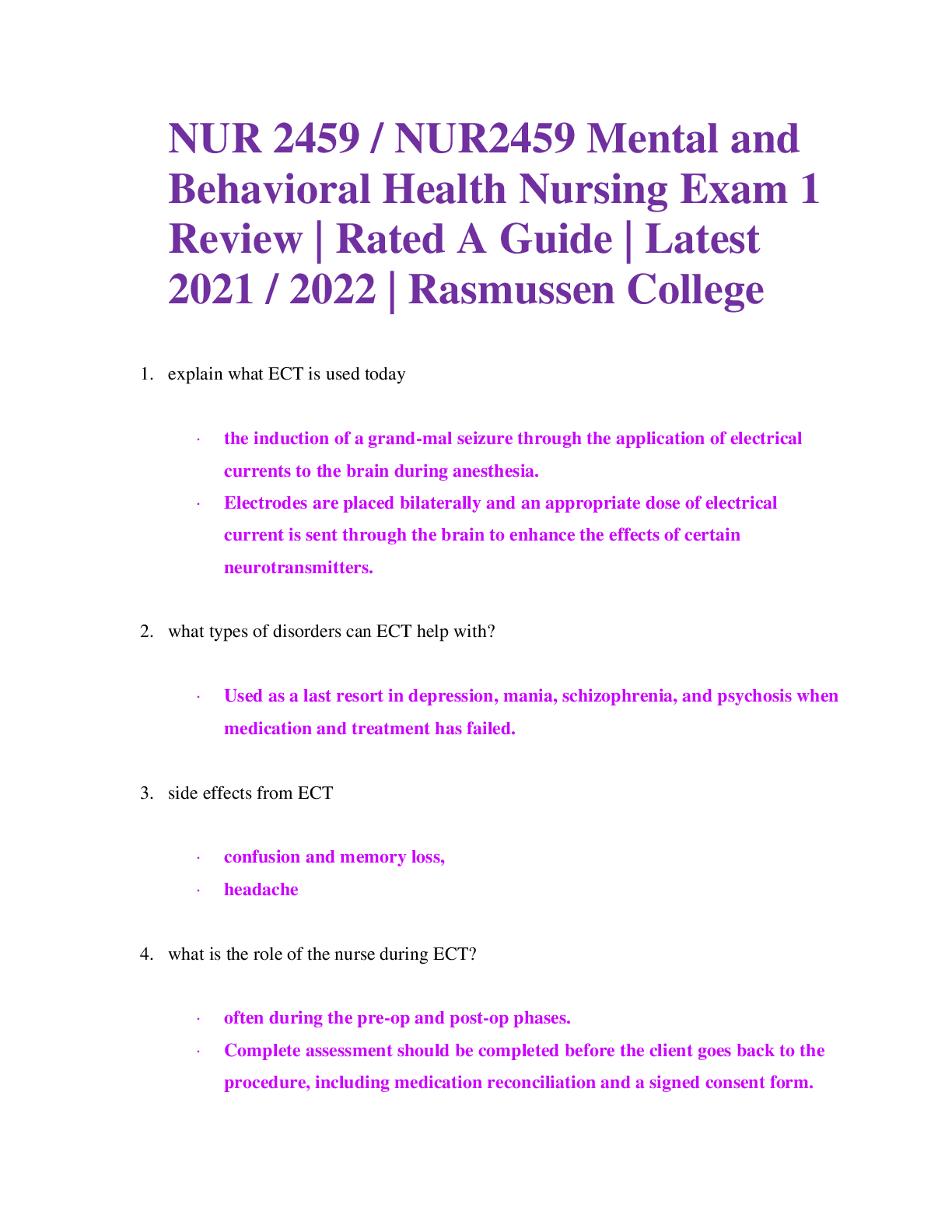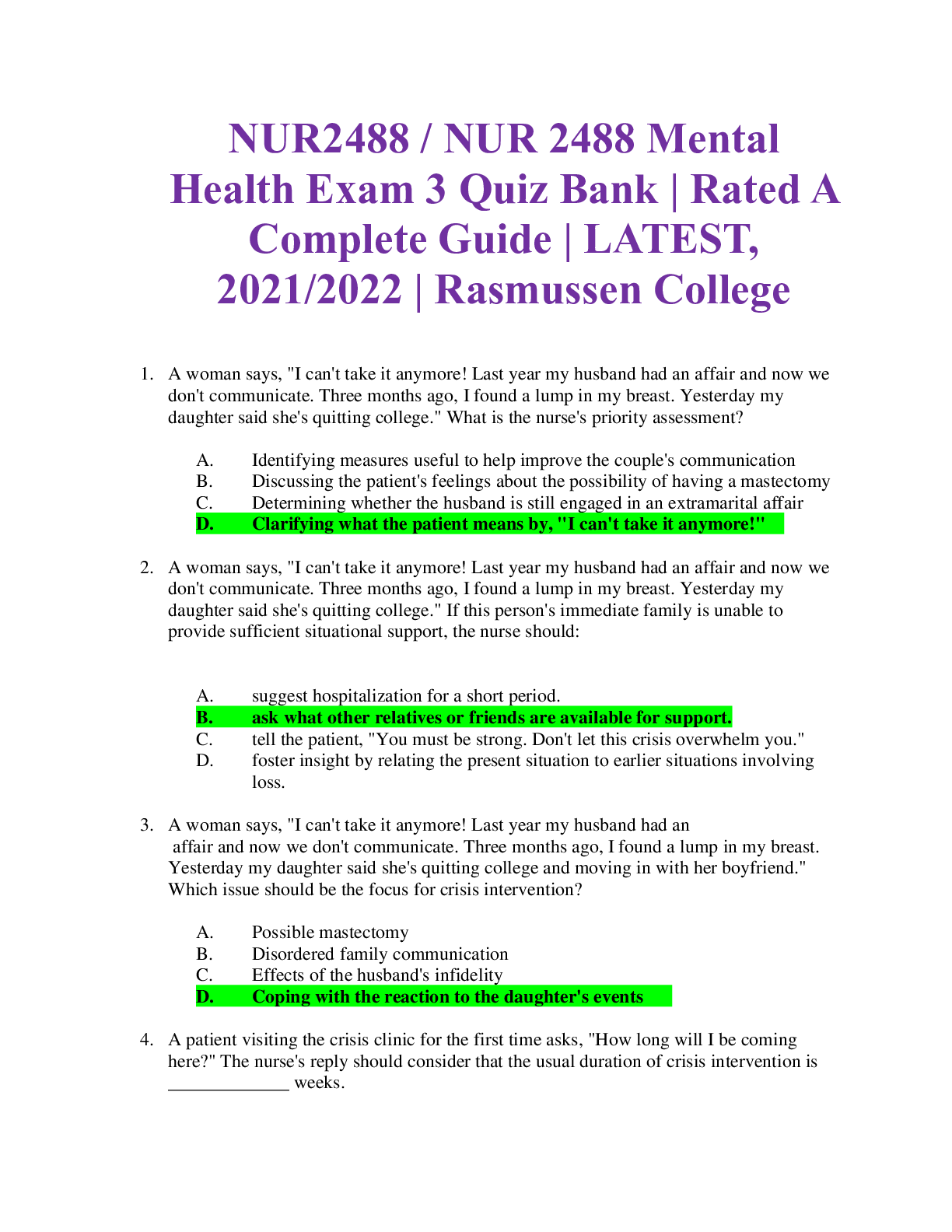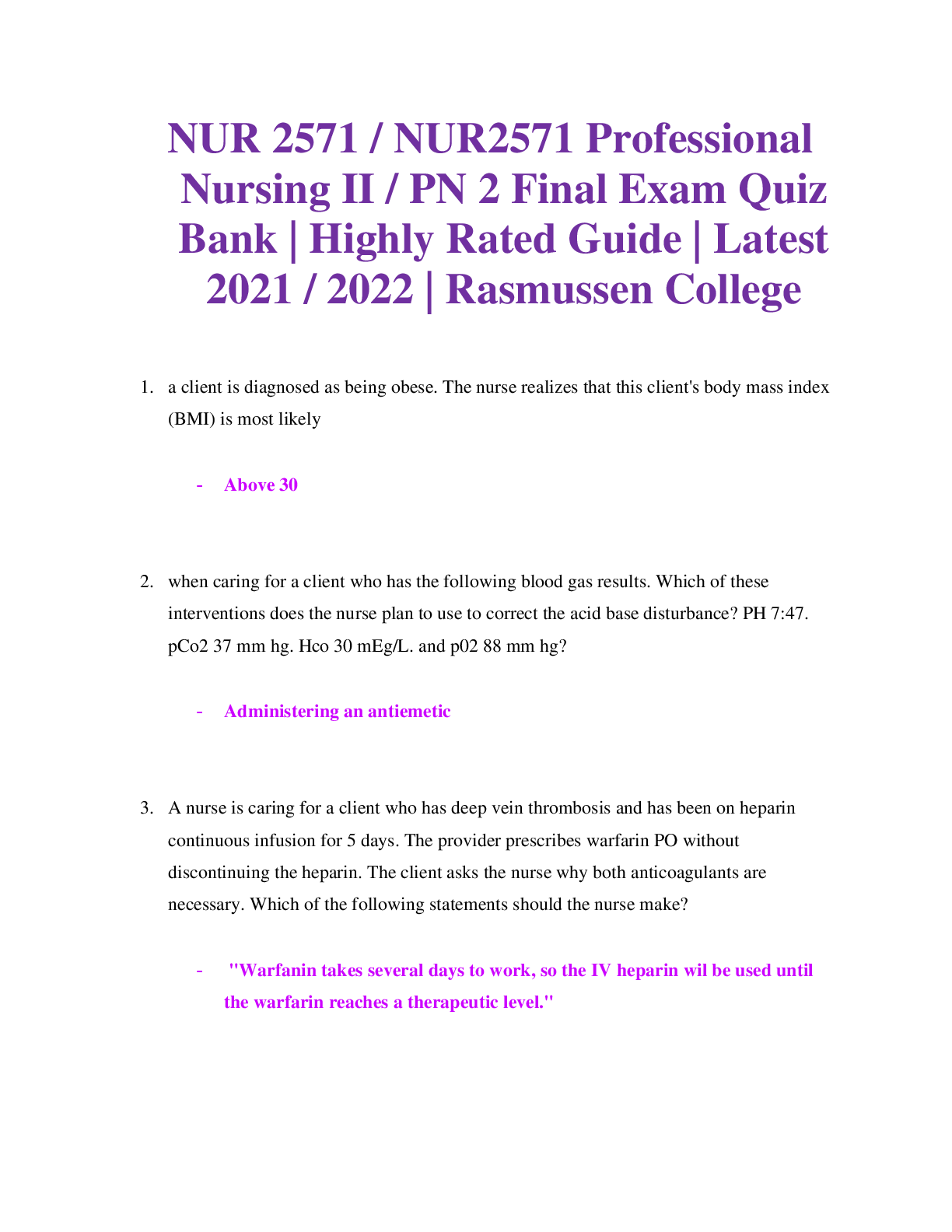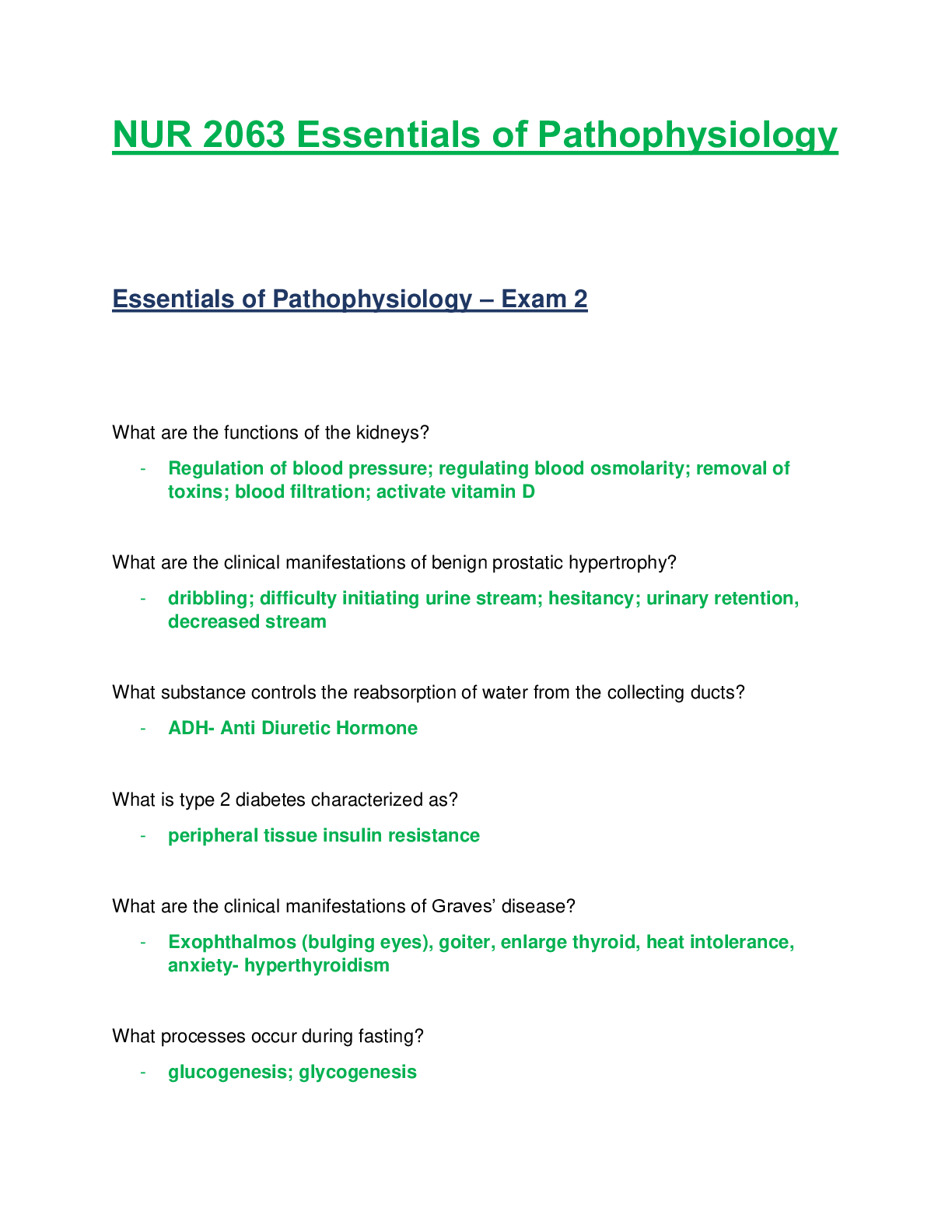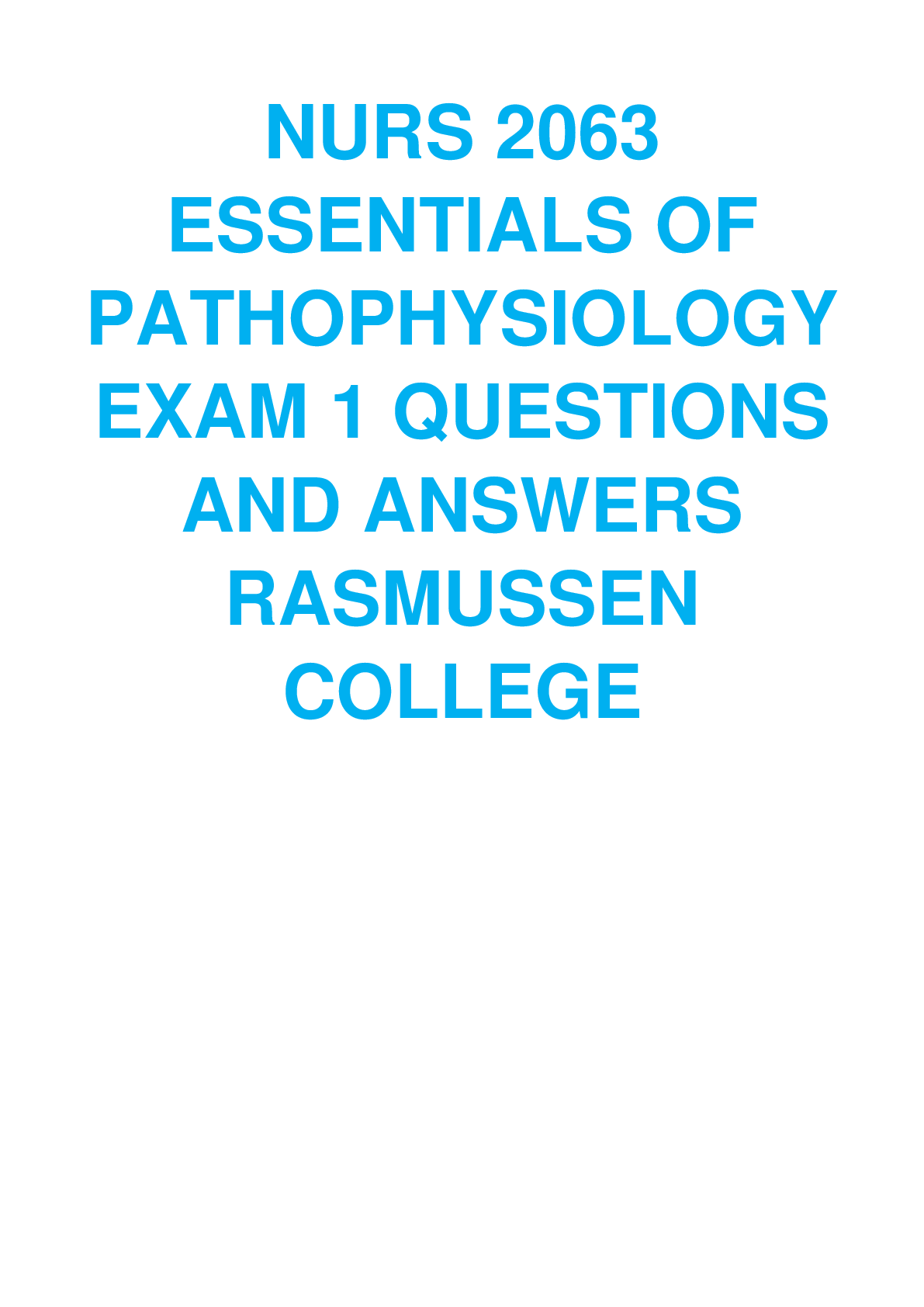Health Care > EXAM > NUR 2063 / NUR2063 Essentials of Pathophysiology Exam 1 Review| Highly Rated Complete Guide| Latest, (All)
NUR 2063 / NUR2063 Essentials of Pathophysiology Exam 1 Review| Highly Rated Complete Guide| Latest, 2021 / 2022 | Rasmussen College
Document Content and Description Below
NUR 2063 / NUR2063 Essentials of Pathophysiology Exam 1 Review| Highly Rated Complete Guide| Latest, 2021 / 2022 | Rasmussen College What is Pathophysiology Correct Answer: is the study of what ha... ppens when the normal anatomy and physiology go wrong, causing disorder and disease process of the human body. What 4 things does pathophysiology include? Correct Answer: Etiology, Pathogenesis, Clinical Manifestations, and Treatment Implications What is etiology Correct Answer: study of causes or reasons for phenomena. Includes Idiopathic conditions that have an unknown origin or cause. What is pathogenesis? Correct Answer: development or evolution of disease from initial stimulus to the expression of manifestations as time occurs. What are clinical manifestations? Correct Answer: Signs and symptoms of disorder. What are treatment implications? Correct Answer: Which combine the etology, pathogenesis, and clinical manifestations to determine the best treatment of condition per individual. What are signs? Correct Answer: Objective or observed manifestations of disease. What are symptoms? Correct Answer: Subjective feelings of abnormality in the body. What is objective data Correct Answer: What you observe and can measure. What are examples of objective data? Correct Answer: rash, low blood pressure, bleeding What is subjective data? Correct Answer: What the patient may report to you What are examples of subjective data? Correct Answer: pain scale, they feel suicidal, fatigued. What is epidemiology? Correct Answer: study of the patterns of disease involving populations. Based on the spread and contact of diseases in people. What are the levels of disease prevention? Correct Answer: Primary, Secondary, Tertiary Explain Primary Prevention Correct Answer: "Preventing"; altering susceptibility or reducing exposure of disease for people. Examples of Primary Prevention Correct Answer: Vaccinations and Handwashing Explain Secondary Prevention Correct Answer: "Screening"; early detection, screening, and management of disease to catch disease early before it spreads Examples of Secondary Prevention Correct Answer: PAP smears for STDs, lab work for HBA1C check, mammogram Explain Tertiary Prevention Correct Answer: "Treating" and preventing further complications from a disorder or disease after the person has the condition Examples of Tertiary Prevention Correct Answer: Rehab for hip surgery, relearning ADL's after amputation, Wound care after stroke to prevent pressure ulcers. What is homeostasis? Correct Answer: a state of equilibrium in which all body systems are in balance and the body is at its most optimal in functioning. Stable. What is allostasis? Correct Answer: ability to successfully adapt to challenges. It is not a balance but an attempt to adapt to achieve homeostasis. Example: sweating to lower ones body temp. Stages of the General Adaptation Syndrome Correct Answer: alarm, resistance, exhaustion Explain alarm stage of general adaptation syndrome Correct Answer: Where the sympathetic nervous system is activated due to stress. Fight or Flight responses are activated and energy is given off by the HPA axis to flee or fight the danger ahead. Blood must be redirected to vital organs in this stage to give the organs energy to work. Explain Resistance stage of general adaptation syndrome Correct Answer: the activity of the Parasympathetic Nervous system and the endocrine system to return the body to homeostasis. The body should ultimately adapt to the stressor. Explain the exhaustion stage of general adaptation syndrome Correct Answer: Occurs when the stressor is not removed or overcome in the body. The body can no longer return to homeostasis after prolonged exposure to stressor. It causes the body to be depleted and damaged that can lead to disease or death. What complications can occur if stressors are not resolved from general adaptation syndrome? Correct Answer: disease can occur physically and mentally, such as anxiety, depression, headaches, insomnia, infection, and heart disease. Name the hormones released during alarm stage of general adaptation syndrome Correct Answer: Corticotrophin releasing hormone, adrenocorticotrophic hormone, catecholamines( norepinephrine and epinephrine) and cortisol Explain the Role of corticotrophin releasing hormone in alarm stage Correct Answer: activates the sympathetic nervous system and adrenocorticotropic hormone. Explain the role of norepinephrine during alarm stage Correct Answer: helps to slow down certain organs such as the GI and GU systems to prepare the body for fight or flight. Explain the role of epinephrine during alarm stage Correct Answer: Stimulates the fight or flight response by increasing heart rate, bronchodilation of the lungs to increase respirations and amount of air let in, dilates pupils to let more light in, stimulates more glucose to be released. Explain the role of cortisol during alarm stage Correct Answer: released by ACTH reaching the adrenal cortex, this allows for more energy creation to increase glucose and to reduce inflammation. Suppresses the immune system. Explain the symptoms of a sympathetic nervous system response Correct Answer: Pupils dilate, salivation inhibited, increase in HR, bronchodilation of airway, increased respirations, glucose release, inhibit GI/GU. Explain the symptoms of a parasympathetic nervous system response Correct Answer: Pupils constrict, salivation occurs, decreased HR, bronchoconstriction, decreased respiration, GI/GU systems resume action. role of nucleus Correct Answer: control center of the cell, where DNA and genes are stored, produces mRNA to help build body proteins. Can have 1 or more (liver cells), or none (RBCs). role of mitochondria Correct Answer: Powerhouse of the cell. Provides energy in ATP, and has its own set of DNA. Role of ribosome Correct Answer: produces RNA to produce proteins through transcriptions of DNA and translation of RNA into a protein. Can be floating or attached to the Rough ER. Role of lysosomes Correct Answer: helps breakdown and digest dead cells, organelles, or tissues. Role of rough ER Correct Answer: folded membranes that move proteins around the cell. Has ribosomes attached to it and helps produce proteins for the cell membranes. role of smooth ER Correct Answer: ribosomes not attached to smooth ER, helps in the Liver and kidney cells to detoxify, lipid metabolism, synthesis of hormones, and calcium storage. Role of peroxisome Correct Answer: membrane cells that contain oxidase and catalase to detoxify harmful chemicals, breakdown hydrogen peroxide and filter metabolic wastes. Role of Golgi body Correct Answer: stacked membranes that act as the sorter and packager for proteins from the ER. Helps move things in and out of cell. Where is extracellular fluid found? Correct Answer: outside the cell Where is ECF located in the body? Correct Answer: found in the plasma, lymph, CSF, eye humors, synovial fluid, and the GI secretions. Where is intracellular fluid located? Correct Answer: inside the cell Where is intracellular fluid found in the body? Correct Answer: found inside of cells, cytosol. Which electrolytes are found at high concentrations in the ECF? Correct Answer: sodium, chloride and sodium bicarb. Which electrolytes are found at high concentrations in the ICF Correct Answer: potassium, magnesium and hydrogen phosphate, and low concentration of sodium and chloride. What is passive transport? Correct Answer: substances move from a high to low concentration, without energy. Natural What is active transport? Correct Answer: substances move against their concentration gradient with the help of ATP. Low to High. What is diffusion? Correct Answer: molecules and ions distributing evenly in the environment. Passive transport used. Goes from high to low concentration and higher the concentration, the faster the spread. What is osmosis? Correct Answer: allows for fluids to distribute in between the interstitial spaces and intracellular compartments. Water goes low to high. High: high solute concentration to low water concentration Low: low solute concentration to high water concentration Examples of ways fluid enters the body (Intake) Correct Answer: Food, Drink, IV access. Examples of ways fluid exits the body (output) Correct Answer: Sweat, Urine, stool, water vapor from lungs, wound drainages, NG secretions. What is dehydration? Correct Answer: when water output exceeds intake over time. Water from ECF is lost, causing cells to shrink as concentration increases. What are the causes of dehydration? Correct Answer: hemorrhage, severe burns, vomiting, diarrhea, sweating, water deprivation, diuretic abuse, DM. What are the signs and symptoms one may have dehydration? Correct Answer: dry mouth, extreme thirst, dry skin, decreased urine output, weight loss, mental confusion, hypovolemic shock. What is hypotonic hydration? Correct Answer: Over hydration or water intoxication. When too much water is taken in too fast or the kidneys cannot rid the fluid fast enough (renal failure). Concentration of water in ECF increases, while osmolarity decreases, causing cells to swell. What things can cause hypertonic hydration? Correct Answer: Too much fluids through IV, renal failure, drinking too much water too fast. ` (Hyponatremia). What are the signs and symptoms of hypotonic hydration? Correct Answer: leads to Nausea and Vomiting, muscles cramping, cerebral edema (brain cells can swell and burst) , convulsions, coma and death. What is edema? Correct Answer: accumulation of fluid in the interstitial space. Leads to tissue swelling. What are the causes of edema? Correct Answer: Increase in the forces that move fluid from capillaries to interstitial compartments or decrease in the opposite. [Show More]
Last updated: 1 year ago
Preview 1 out of 16 pages
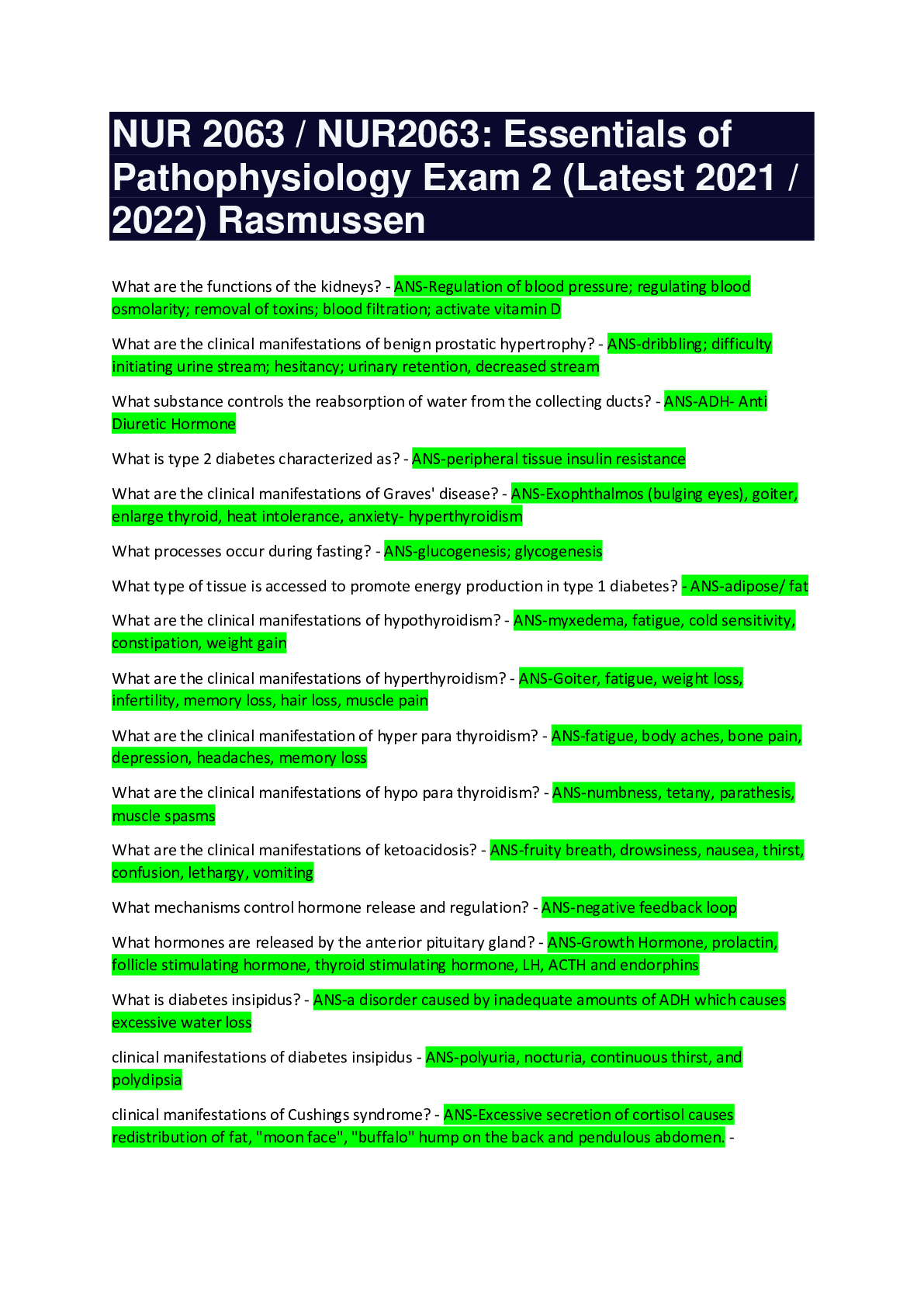
Reviews( 0 )
Document information
Connected school, study & course
About the document
Uploaded On
Jul 20, 2022
Number of pages
16
Written in
Additional information
This document has been written for:
Uploaded
Jul 20, 2022
Downloads
0
Views
14


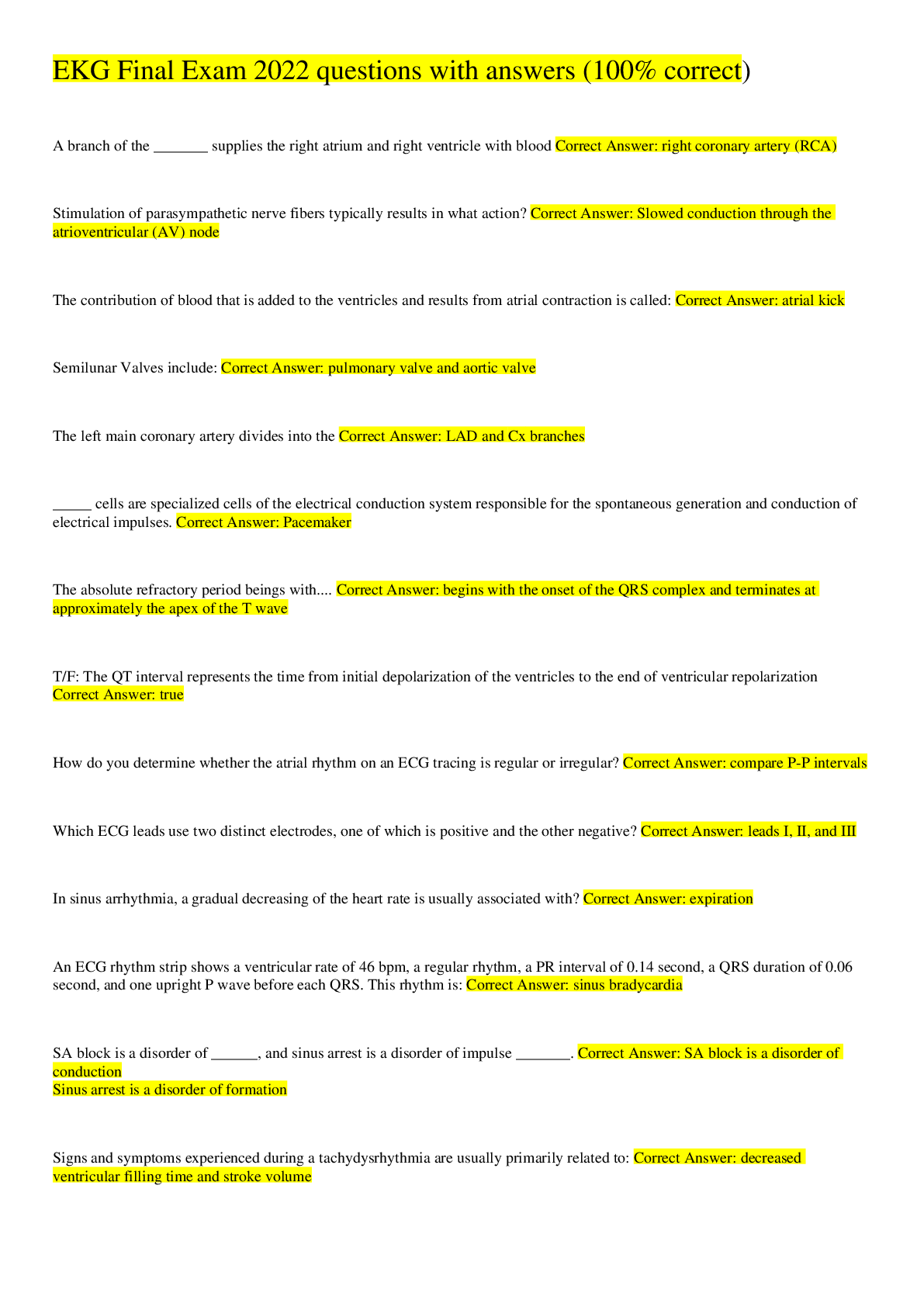
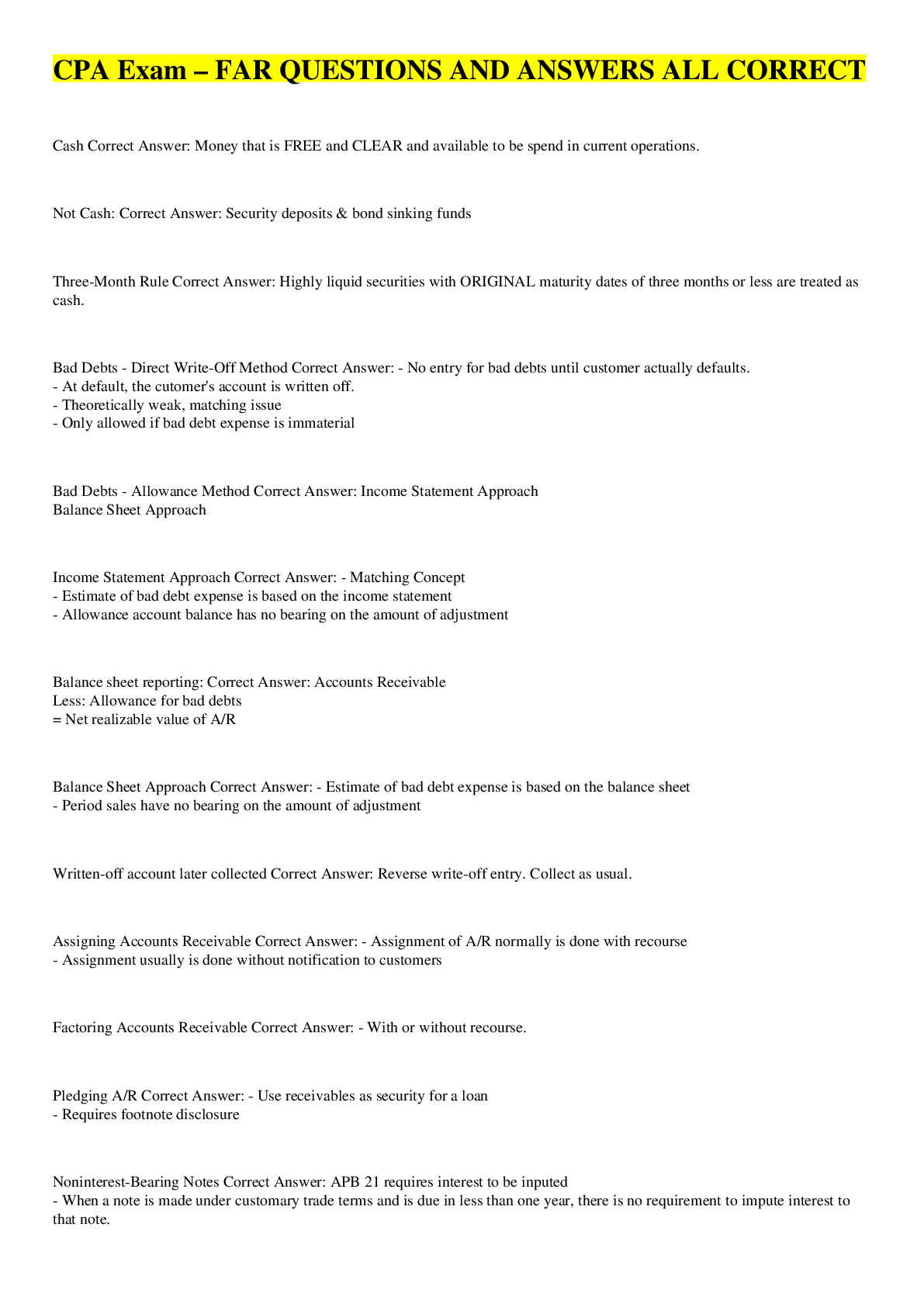
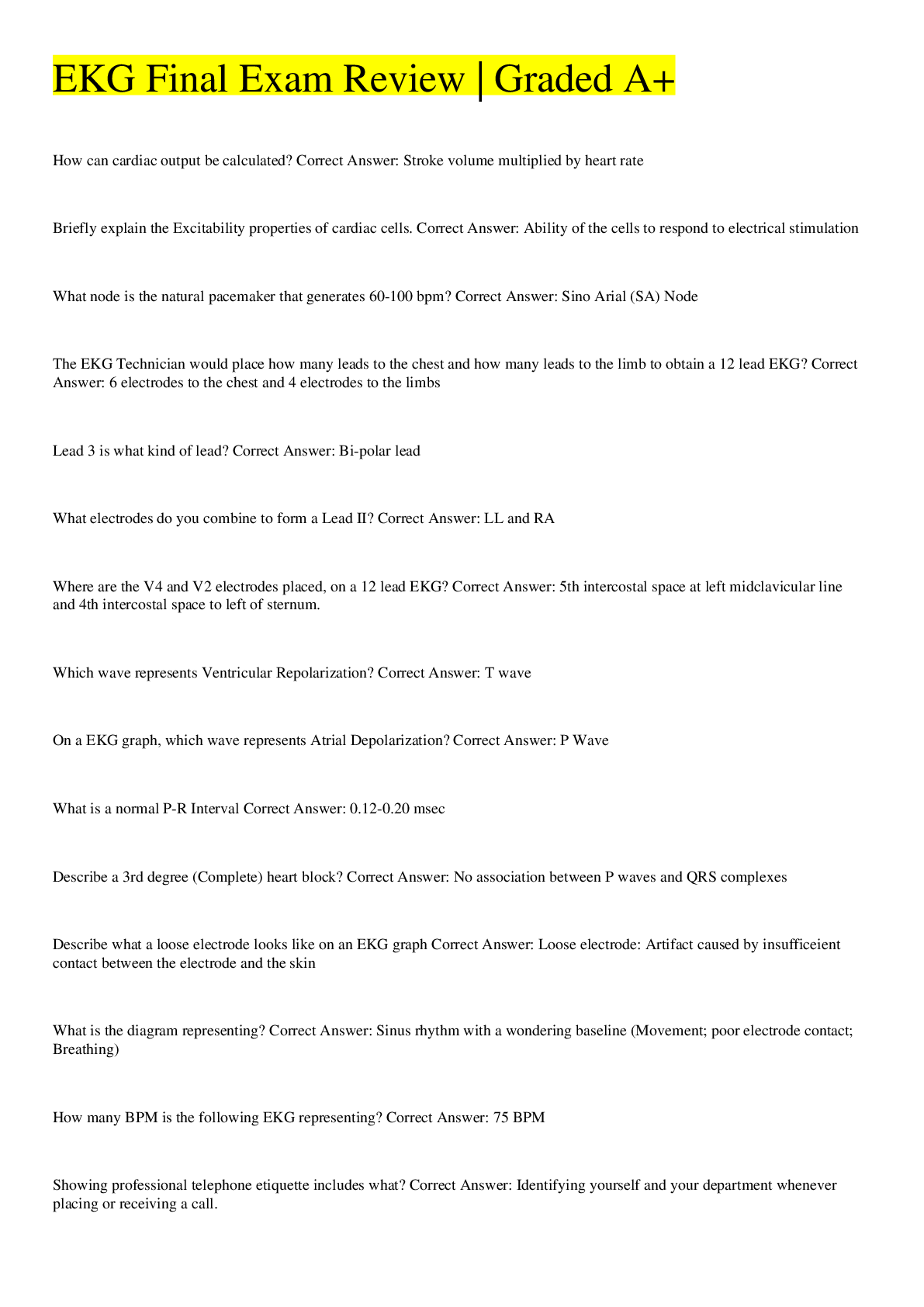
.png)

